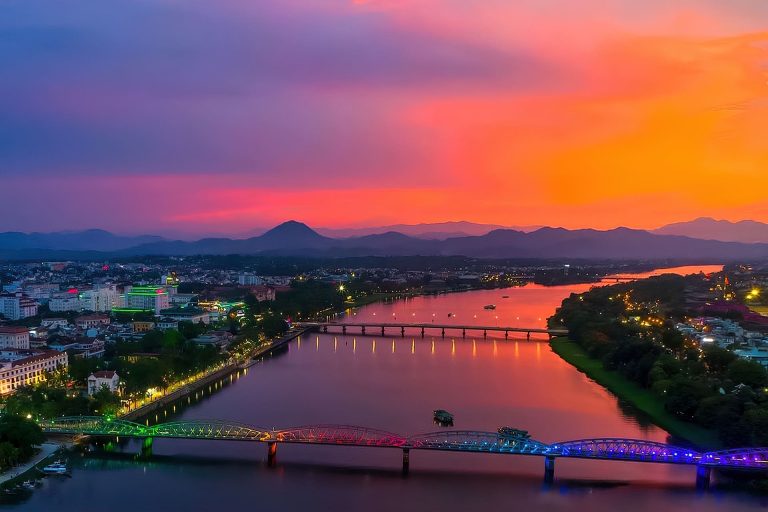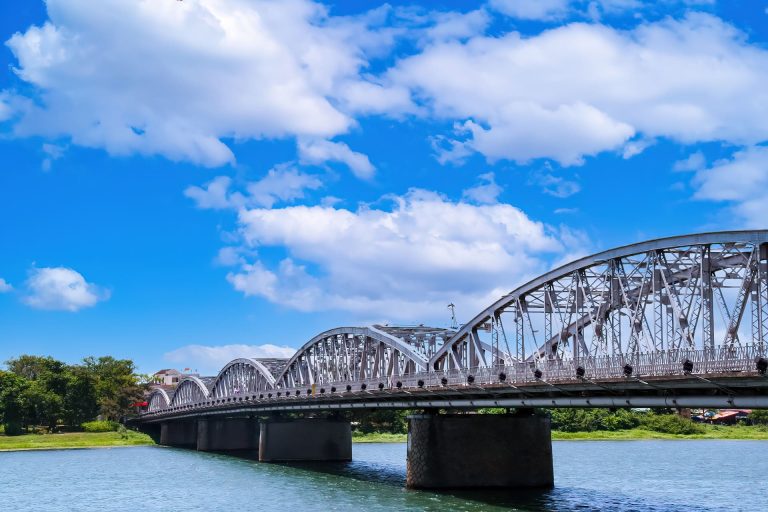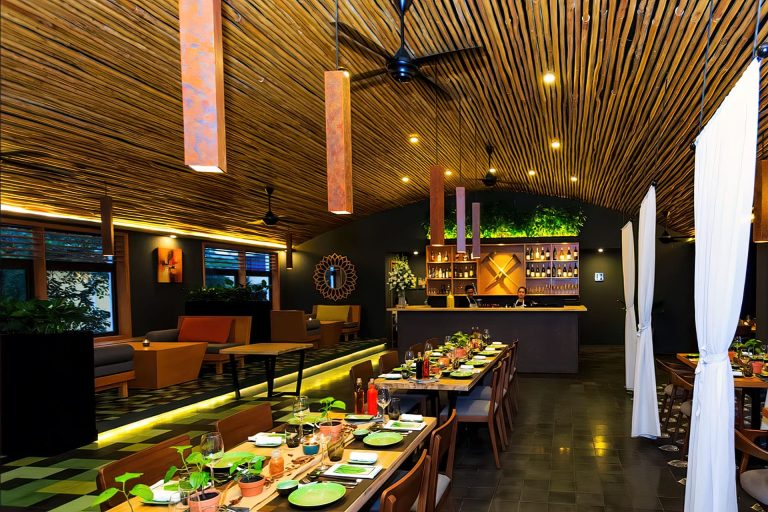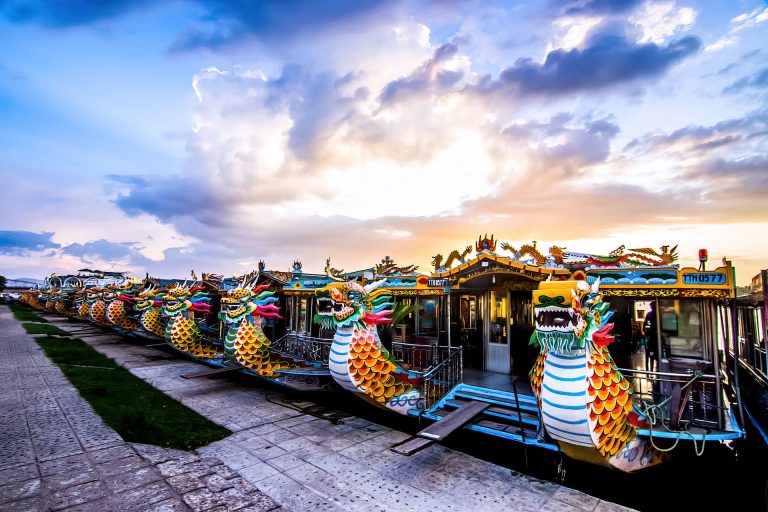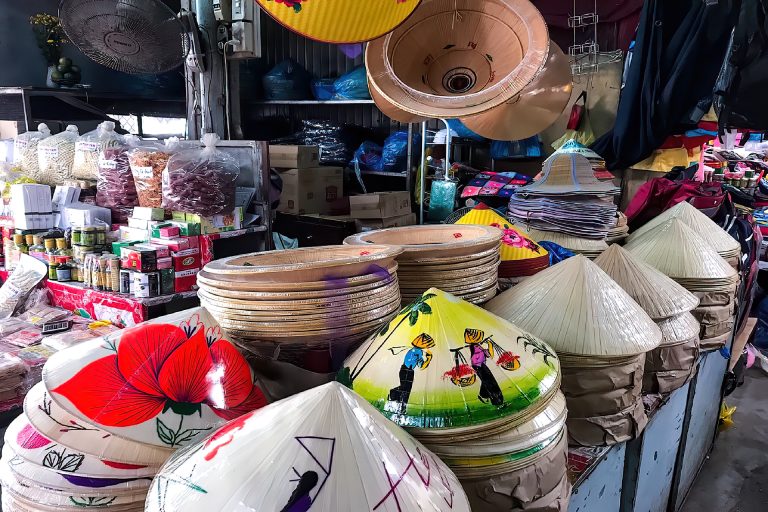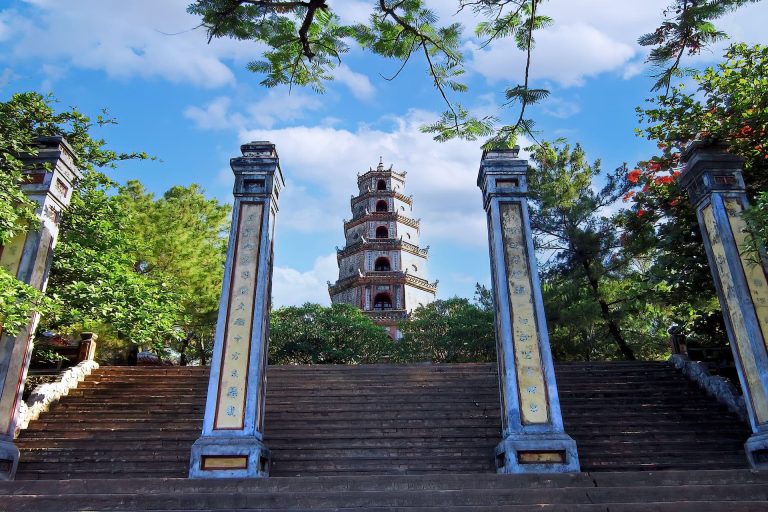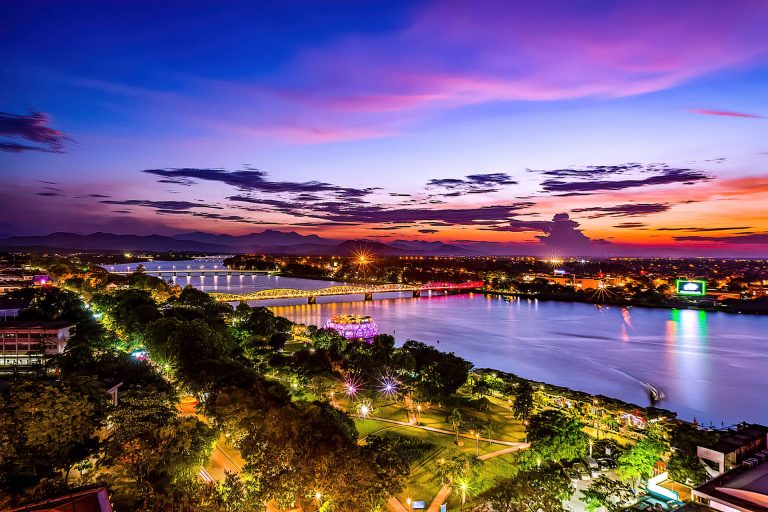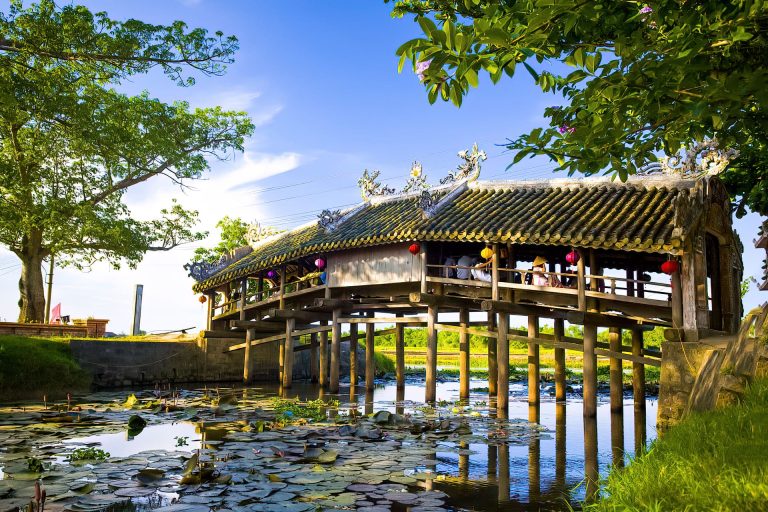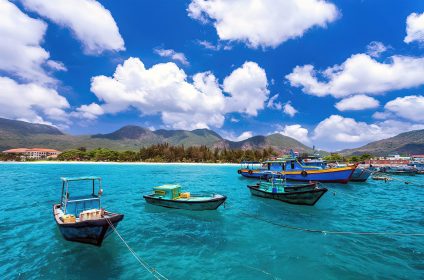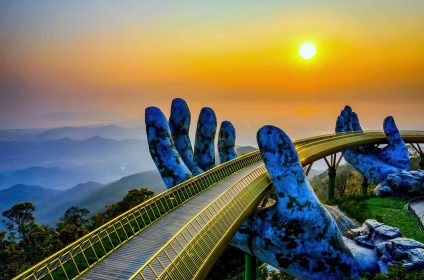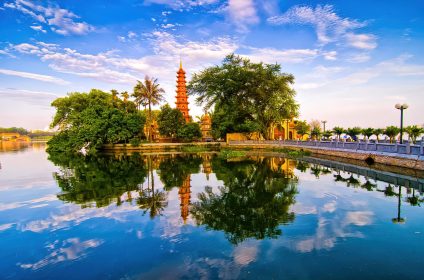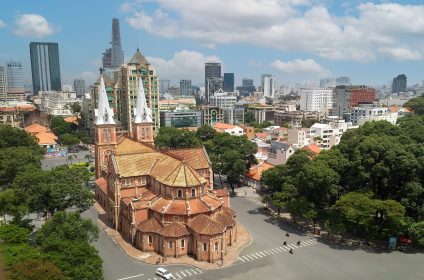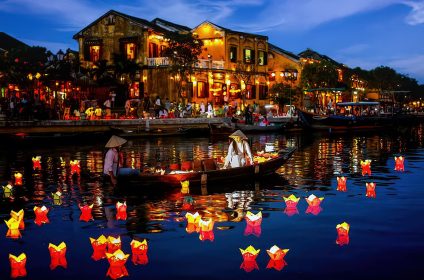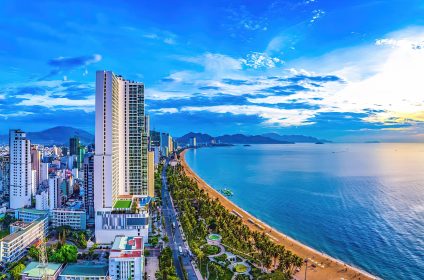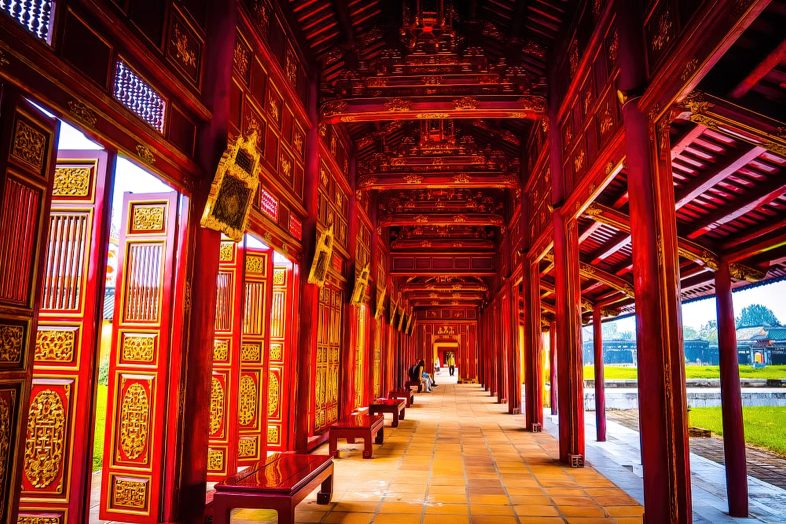
Attractions & Things To See In Hue
A trip through the old quarter of Hue will give one a lot to talk about; there are distinctive historical sites at every corner. Among them are tombs of the last eight Nguyen emperors, which today are located in the palaces where these emperors dwelled several centuries ago. Each of these palaces has a beautiful garden. The Mausoleum of King Minh Mang that was built in the first half of XIX century is one of themost beautiful ones. Ancient pines surround the palace grounds with a large bronze statue erected here to honor this great king.
The Tomb of Tu Duc (Mausoleum of King Tu Duc) is one such notable architectural complex. Apart from the palace, they have preserved an old reading pavilion and a genuine chess room with utmost concern for detail. Once upon a time, long ago, an open-air stage fringed by exotic plants hosted various performances on this spot. The Tomb of Khi zr is another remarkable architectural sight from the early 20th century, located on top hill (Mausoleumof King Khai Dinh). It’s surrounded by harsh walls of defense. While it was being constructed pieces glass and phosphorous were scattered around haphazardly. Many people are very eager to see it at night in order to notice barely traceable gleams on its walls.
The most striking building in Hue is The Royal Palace. Some lovely halls can now be visited here by tourists too. The new ruler’s coronation events were held here in this palace among others as well as privy council chamber royal living room and several temples easily accessible by visitors.Hence , it is also possible to find former royal family’ s dwelling located inside Purple Forbidden City . In many rooms , original setting remained unchangeable . Luxurious queen suite and equally luxurious concubine rooms will also be found within thiscomplex . One amongmost interestingplacesisroyal kitchen.
Outside the Royal Palace, there are a number of interesting places to visit, including the Pagoda of the Lady of the Heavens (Thien Mu Pagoda). A women came here at the end of 15th century and showed locals a sacred place on Perfume River bank according to a beautiful tradition. Soon after construction of pagoda started here and it still looks like this since XVII century. It would not be easy to find similar things in other towns as in Hue. The Tiger Fighting Arena is one such location.Like many royals, this type of entertainment was quite popular among them. In addition to tigers, there were also elephants competing in it too. The last fight that took place inside any arena of hue was held in 1904 year.
The Noon Gate (Southern Gate Ngomon) is another eminent architectural site.The main among four gates in citadel may only be open for special occasions. As an icon which has kept its status forever, it would definitely be right for tourists visiting Hue not to overlookthe PerfumeRiver. Everyone can take an interesting boat trip just for finding out how beautiful these sites are. Both sides of this watercourse have rich woods full offine trees and sweet-smelling flowers.Unique historical sights along with natural attractions abound in the compact city of Hue which terrain is extremely comfortable for walking across it.
Imperial Citadel (Đại Nội)
This enormous complex of temples, pavilions, moats, walls, gates, shops, museums, and galleries features art and costumes from various periods of Vietnamese history. It is the old imperial capital and Hue’s main attraction. It is also beautifully peaceful, an uncommon commodity in Vietnam, due to its size. It is quite expansive; expect to spend at least three hours there.
The citadel was severely damaged during the 1947 conflict between the French and the Viet Minh, and again in 1968 during the Tet Offensive, when it was shelled by the Viet Cong and then bombed by the United States. Consequently, some locations consist solely of vacant fields, wall fragments, and an explanatory plaque. However, other structures are intact, and a few are in pristine shape. While repair has been ongoing for 20 years, there is still a considerable distance to go. Allow many hours to fully appreciate it. Admission is 150,000 dong for adults and 30,000 dong for children ages 7 to 12 (Feb 2017) (for foreigners, obviously less for locals), and the park is open from 06:30 to 17:00. Inside, for $1.50 (75,000dong), you can wear the attire of the King or Queen and sit on the throne for a wonderful photo opportunity.
- Ngọ Môn. The southern main entrance to the city was made by Emperor Minh Mang in 1833. The central gate and the bridge leading to it were reserved for the emperor alone. Climb to the second story for a breathtaking perspective of the courtyard. Ngo Mon Gate is an entrance into a fortress zone. Emperor addresses his officials and people from above this gate.
- Thái Hòa Palace. The name of this building is Thái Hòa Palace which is also known as the Palace of Supreme Harmony. For important events such as birthdays, assembly sessions and talks with foreign diplomats, Thai Hoa Palace may be used twice a month. The major indoor feature of Thai Hoa palace is its grand throne which was utilized for receiving salutes and listening to important court reports from ordinary civil servants and military officials.
- Trường Sanh Residence. The Truong Sanh Palace, also known as the “Palace of Longevity,” was the home of the mother of King Tu Duc, Empress Tu Du, during the 19th century Nguyen Dynasty. It is situated in one of two main parts that make up Hue Citadel, Tu Cam Thanh. That encompasses reconstructing Lach Dao Nguyen, a moat around the palace, man-made ornamental rockeries and mountains; bonsai gardens and gates leading to it. The project will cost approximately 30 billion dong (VND) or $1.8 mln. Restoration works should be completed by 2009 but this is highly unlikely. Though not officially open to visitors, it is possible to enter them and recommended because they are still beautiful even when overgrown with vegetation as at present date.
- Forbidden Purple City. Directly behind the Thai Hoa Palace, however, it was almost totally destroyed during the 1968 Tet Offensive, leaving only the Mandarin Palaces on either side that are somewhat less striking.
- Hue Jungle Crevice. When Hue was seized only for a short period by Viet Cong, they singled out about three thousand inhabitants and officials who were then tied together and pushed into the abyss in order not to slow down their retreat.
Tombs of the Emperors
The Tombs of the Emperors, located south of the city along the Perfume River, are one of Hue’s other major attractions. They can be reached by taxi or bicycle from the city, but the best way to see them is to charter a riverboat and take a cruise. Plan for a full day, although if you rent a car it will only take a few hours to explore the attractions of interest.
Typically, group tours cost approximately 200,000 VND, which includes lunch on the boat. The lunch consists of modest quantities of rice and veggies, with the opportunity to select additional items for an additional fee. The price of the tour does not cover admission to the tombs (150,000 dong per person as of April 2015 – count your change carefully if paying with large bills, as short-changing can occur) or the cost of a motorbike from the pier to each tomb. If you are traveling in a group, the price should be approximately 25,000 dong per round-trip. Choose a journey with the fewest potential stops. Tour firms aren’t known for their time management, so you’ll be hustled through at least one of the tombs.
If you are traveling alone, boat rental or a motorbike with a driver should cost roughly $20, not counting tomb entrance fees. All of the tombs can be reached on foot in ten to thirty minutes from the wharves. Even though the paths are fairly obvious, you should probably not attempt it without a map or an exceptional sense of direction. Depending on the season, most tombs are open from 7:30 AM or 8 AM to 5:30 PM; notice that tour groups arrive from 10 AM and leave at 3 PM in order to return before dinner, so plan appropriately to avoid congestion. You’ll be pleased you did.
The tombs are also easily accessible by bicycle, however there is a dearth of accurate maps on how to get there. Inquire at your accommodation about bicycle rentals and maps, and exercise caution on the congested and perhaps pothole-ridden roads. This is perhaps the cheapest (and most entertaining, if you enjoy riding) method of reaching the tombs.
The tombs themselves merit the expense and effort. They date primarily to the late 19th or early 20th century, when the Emperors were reduced to figureheads under French colonial control and had little to do save construct beautiful tombs for themselves. The Tomb of Tu Duc, the Tomb of Minh Mang, and the Tomb of Khai Dinh are three of the finest examples of Buddhist aesthetics and architecture in Vietnam. The older ones have been allowed to fall into magnificent semi-destruction, while others are currently being repaired.
There is no concession for Vietnamese visitors, who must pay the same costly admission fee as Westerners.
In ascending order of age:
- Tomb of Gia Long (20km) – the most isolated of the tombs, quiet and in ruin, as Gia Long, the first Nguyen emperor, was notoriously cruel.
- Tomb of Minh Mang (12km, 7 am-5.30 pm, 150,000 VND/ person) – Located within a wall and over several hectares, it is possibly the finest of the bunch. Minh Mang was unquestionably a rural boy at heart, as a result of the area’s wooded and watery setting. On an east-west axis, the principal structures are arranged, including a courtyard encircled by warrior statues and various temples and pavilions. Several bridges span two lakes before the axis terminates in front of the enormous burial mound (which is circled by a fence). If you are dropped off by boat, be aware that the short walk to the mausoleum’s entrance is lined with souvenir vendors. The same applies to the car/coach/motorcycle parking lot, but they are merely attempting to make a living. Bike park is only 5000 dong. Expect approximately one hour.
- Tomb of Thieu Tri (8km, 7am-5pm, 40,000 VND) – built in 1848. This Emperor and his wife were the most esteemed and beloved in the entire nation. Even though he only ruled for seven years, he was deeply missed. During a time of conflict and economic difficulties, he was prudent with the country’s finances and worked to improve the living standards of his people. His last will and will stipulated that he be interred in a modest tomb, breaking with the tradition of grandiose tombs for their Emperors. As of September 2015, there is hardly much to see at the tomb, so plan to spend no more than 15 minutes there.
- Tomb of Tu Duc (7km, 7am-5 pm, 150,000 VND) – The complex, constructed between 1864 and 1867, operated as a second Imperial City where the Emperor took “working vacations.” The setting and arrangement of the fifty structures that once stood on this site reflect the peaceful and poetic essence of Tu Duc. A massive, expansive complex built around a lake, with wooden pavilions, tombs, and temples devoted to spouses and favorite courtesans (Tu Duc had 104 to choose from). Other portions are astonishingly well-preserved, whereas the courtesans’ lodgings are in ruins, with only outlines and crumbling walls remaining amid waves of overgrown grass and quiet. The tomb of the Emperor, nestled away at the back, is shockingly small; the final courtyard is virtually empty, with only a stone casket in the center. Also placed here are the tombs of Empress Le Thien Anh and Emperor Kien Phuc, who ruled briefly in 1884. Try to avoid the crowds at this event. Anticipate spending an hour and a half.
- Tomb of Dong Khanh (8km, under construction, still free as of Sep 2015) – built in 1917. Only the entrance gate and a temple facade is ready. Expect to spend no more than 5 minutes.
- Tomb of Khai Dinh – This is a monument and tomb for Khai Dinh, one of the last monarchs of the Nguyen Dynasty. It is the final Imperial tomb constructed in Hue. It can be found near the base of Mount Chau Chu. The grounds are compact, but the design and construction are extraordinarily detailed and comprise a complex mix of Eastern and Western architecture. There are two distinct sections inside the tomb grounds. At the tomb’s entrance are the doorway and steps leading to the courtyard. Outside the palace, the courtyard is bordered by mandarin residences adorned with statues of guards. The mausoleum of Emperor Khai Dinh is located within the palace. The hexagonal stele pavilion is a must-see since it features a design unique to Hue during this period. Khai Dinh’s favorable relations with the French lowered his reputation slightly. The tomb displays a reverence for global prosperity. Steel, iron, and tiles from France, as well as ceramics and stained glass from China and Japan, are some of the world’s finest materials from this time period displayed in the tomb. It is 9 kilometers south of Hue via road. Hours of operation are 07:00-11:30 and 13:30-17:30. Admission costs 80k VND.
Historic Sites
Ho Quyen
A former royal combat demonstration is what makes this historical landmark significant. It’s just about 3 kilometers from the city center of Hue. In English, this same arena is referred to as ‘The Tiger Arena’. Tigers and elephants used to battle each other to death in it. The Royal Courts of Hue had a good time participating in or watching these actions.
Looking at it with modern eyes, it is horrifying but elephants were not treated like tigers. The Royals preferred using elephants for battles. They were big and strong animals which could be easily used for transportation purposes among others. On the other hand, tigers were viewed as dangerous by people. At that time, tigers acted at their own pleasure even going so far as raiding communities for food. They were hated by villagers because they constantly killed their cattle and sometimes even people. To ensure completeness and perfection, Imperials kidnapped wild tigers and staged fights between them and elephants; just likes Rome gladiators’ lives depended on Emperors’ choices.
It was brutal towards these tigers. Elephants on the other hand were revered rather than feared since they represented good fortune in many Asian cultures.Having become declawed severely restricted tiger movement while being chained limited their range completely.Then their teeth wore down making them harmless during games.Think of Roman Emperor Commodus’s great battles against weaker-bodied gladiators fighting with blunt swords.Tigers of course fought bravely but fell short before those mighty trampling Royal Elephants who mashed them into meat paste.
373 Bui Thi Xuan, Phuong Duc, Thanh Pho Hue is where “Tiger Arena” is located on the southern bank of Perfume River.Watching places are few.Admission fee is free
Nam Giao Esplanade
Hue Citadel can be found in the South; it is bordered by an alley shaded by trees and green bushes that creates silence. Previously, mandarins and other officials who kept this place holy were always praised for their prudence. It was a focal point where the Royal Emperor would bring presents and worship Gods. The terraces are formed to represent the works of God, which include heavenly creation and terrestrial creation as well as human creation.
Only the king had supreme authority as the emperor under God to say what could or could not happen during these visits. Every three years there was a ceremony of offering sacrifices to Heaven. They continued until 1945 after which they ended with the fall of Imperial Dynasty. Besides primary offerings, there also are celebrations and dances dedicated to heaven done at that time. The community at large benefited greatly from these events. Loyal courtiers and servants received favors such as pardons, presentations as well as loyal courtiers and laborers while others are given them.
This part is made up of circular-pierced paving stones on top esplanade which is circular-shaped itself. On days when sacrifice will take place a blue tent will be set up along side this esplanade’s edge. This was an offering made to the supreme being (God). For purposes of offering yellow paint was used on square terrace below that represented earth while red color representative of man, therefore giving us a reason for painting it red on lower esplanade unlike the rest squares painted differently starting from red square representing man through yellow square representing earth finally ending you with green one representing sky.The fasting palace that stipulates abstinence, divine kitchen where animals were offered sacrifices and divine storeroom where sacrifices were stored surround this esplanade.
This spot has much spirituality ingrained in it.Emporers would tolerate diverse religious practices.They believed if they performed such rites properly,the richess of gods would come into their lives as well as the lives of their people.Today there is no evidence of this.Despite being so, it is considered a spiritual relic and one of the most important altars of Nguyen Dynasty. It is part of the Hue Monuments Complex which has been named a UNESCO World Heritage Site.
Nam Giao Esplanade is located in Truong An, Thanh Pho Hue, Thua Thien Hue. They open at 8 am and close at 5 pm. There are no charges for admission.
Imperial Enclosure
This place had been a site for Emperors and the royal family who came here to enjoy beauty and have pleasure that goes with such noble status. The Nguyen Dynasty of Vietnam ruled this area. It was a place of great honor too. Hue locals were fascinated by it too. That’s why it was turned into a site of lust, and then ruined due to the people’s greed for more riches and needs through conflicts.
It used to be an inner part of a fortress meant for protection purposes. The moat is reminiscent of the East Asian kingdoms that existed at the time. In Beijing also there exists Forbidden City which is structured in the same way as this one. In these cases mimicry is considered as flattery. The case with this brach outlet is not different either. Built between 1802-1833 And it took three decades to build it. There was a complex Feng Shui system employed during its construction. This showed how powerful the king himself could be when he wanted to dominate that region or section or even anything else! It safeguarded royal assets within its precincts too! The structure’s symmetry can be seen in its landscape and portrayal of its shape as well. On left side we have mountains, which protect from outside world because dragons are supposed to protect their nation, while on right hand side we have white tigers protecting against evil spirits according to their beliefs’. At times colors, elements or cardinals played roles in designs like these; thus images and pictures may never seem enough! Its symbolism is widespread throughout Vietnamese culture today too!
The enclosing wall has an approximate diameter of about ten kilometers but height being around 6.6 meters tall respectively.. Bricks replaced mud formations previously associated with them whereas moat or ditch surrounds perimeter walls.. There are four major gates entering this area.. Meridian Gate serves as the main gate facing southwardly towards South.. Midday Gate happens to face towards the King’s palace, which can only be used by people with royal bloodlines. The other entrances face cardinal directions of north, east and west respectively.. This is the Forbidden Purple City inside the citadel analogy that originates from the one in Beijing.. It acted as a home for selected few during Nguyen Dynasty.
The citadel was under severe scrutiny after the fall of Royal Nguyen power in 1945. In 1947 French-Vietcong protracted conflict resulted in incineration of Imperial Area center. Additional parts were destroyed after Hue fell to a revolutionary attack in 1968. Today there are just ten major sites after having been named a UNESCO World Heritage Site in 1993. Some such places are currently being rehabilitated also while others do not even exist now.. As I write this article, some famous sights include Pavilion of Splendour, Gate of Manifest Benevolence or Palace Fronting on to Supreme Harmony.. Up until now people can still find many ancient furniture within this place.
Most importantly, it is known that this citadel is what characterizes Hue best. Its atmosphere resembles that of an imperial era long gone with all its artifacts and riches. Yet whatever condition these buildings are in or how much they have fallen apart does not really matter because essential feng shui principles made sure it got what it indeed deserved! It is about an old colonial period which wind has almost swept off.
Its location is Than Pho Hue, Thua Thien Hue where Imperial City is situated. It remains open throughout day starting at eight and closing at five each evening but also stays until twelve o’clock midnight on Thursdays again.
Temples In Hue
Thien Mu Pagoda
Thien Mu Pagoda is one of Hue’s cultural symbols, comprising seven stories and situated on the northern bank of Perfume River. It got its name from the legend about a local old woman who had predicted the construction of a pagoda to pray for the nation’s prosperity. She was called Thien Mu or Celestial Lady. This place was built as Buddhist temple by Nguyen Dynasty.
In 1601, orders were given and constructions began. The initial location has been altered through multiple renovations and expansions. Bodhisattva Vows were bestowed upon the Pagoda by Zen master from Chinese Buddhism, while Patronage fell on Lord Nguyen Phuc Chu. As a result, this turned into an armed worship site for Buddhists. Commissioning sculptures of celestial realms and the ten kings are included in this expansion, as well as building many halls, bell towers or living rooms for Sangha.
Buddhism is celebrated in many ways at Thien Mu Pagoda. In fact, here lies copies of Tripitaka Canon and Mahayana sutras among others stored here. With a big turtle statue symbolizing long life outside the temple gate that stands out at you like nothing else when you see it; Vietnam is proud of its long-lived inhabitants! There are poems to read telling about pagoda’s history also it’s own one’s history too. Following typhoon damage in 1904, part of the Pagoda was repaired so far it has kept its grandeur and beauty but not experienced serene time that prevailed during ancient Nguyen Dynasty era since there still exists ancient Tran Quang Duc Car owned by Trich Quang Duc only signifying political unrest around Buddhism within Vietnam during twentieth century.
Thien Mu Pagoda is situated in Huong Hoa, Thanh Pho Hue, Thua Thien Hue where it opens daily from 08:00 to 18:00 hours every day
Tu Hieu Pagoda
During the night, if you travel to this place which is roughly 5 kilometers away from Hue Citadel, you will hear chanting that begins at 4:30 am. This pagoda is located near a monastery where practicing Buddhist monks follow Buddhism in its purest form. After midday, there are no lunches and some of the inhabitants engage in studies or do housework. In the nineteen forties, Trich Nhat Hanh, an internationally recognized Buddhist who has advocated for love and peace worldwide studied here. A few Buddhist scholars study at this place.
Eunuchs were the first people who continued the maintenance and preservation of this Pagoda after it was built in 1843. It was created by a retired Royal Sangha who regularly went to forest to collect fresh food for his sick mother. His filial piety grew stronger and inspired him to build a temple dedicated to this struggle with life. The temple contains revered relics on filial piety. There is a graveyard for Eunuchs who sacrificed their lives in order to work towards attaining it.
The Tu Hieu Pagoda lies amidst breathtaking natural scenery. It is one of the most beautiful pagodas in Hue area. Locals come here to pray over their children’s success Visitors appreciate grand architecture mixed with serene pinery groves here.it’s really calm here.expect no loud noise or much excitement but rather contemplation time with movement characterized by slowness.
Tu Hieu Pagoda – situated in Thuy Xuan, Thanh Pho Hue, Thua Thien Hue; Opening hours: 08:00-21:00; People can visit the forest anytime they want.
To Mieu Temple
Also known as To Mieu Temple, the Former Emperor Minh Mang built the To Mieu in 1820s. This temple is dedicated to the Nguyen Dynasty ancestors. This dynasty made Hue into Vietnam’s capital and constructed its Imperial Enclosure. Their Urn can be found in this very shrine. Each of these urns is styled after ancient Chinese dynasties like Xia, Shang and Zhou.
This enclosed yard lies southwest of The Imperial Enclosure. To the south of this courtyard is Hien Lam Pavilion. On the opposite side of the Courtyard sits To Mieu Temple. Inside are Nine Dynastic Urns, each dedicated to a famous Emperor from Nguyen Dynasty. These Urns represent strength, vitality and protection for their dynasty. The middle most Urn shows Gia Long who was one of founders of this Dynasty; it is embellished more than other Urns in this collection.
The temple has been kept well and can easily be reached from the major area of Imperial Enclosure. Some pictures and artifacts here include those left or collected by some Emperors of many Dynasties in China throughout history.
It is one among many attractions within Imperial City that a visitor should not miss when they come to Hue city.
Located at Le Huan, Phu Hau, Thanh Pho Hue, Thua Thien Hue Open hours 07:00-17:00 Dress modestly
Other sites In Hue
Phu Bai Airport
Phu Bai Airport is the place to be if you’re into war. The airport used to be a dusty patch of land in Indochina War times. After that, when Americans based their garrison there in Vietnam War it became improved with concrete bunkers, a paved airstrip and other extras. The airport was vital during the Easter offensive when Hue was running out of supplies after the fall of Quang Tri. The American-built structures originally part of the airport are still there, but have been altered for Vietnamese purposes.
Thanh Toan Bridge – Just a few kilometers outside town is this lovely wooden footbridge. It’s a great spot to see how people live outside cities and often full of locals who want to get away from intense sunlight. It’s not really worth going out of your way for, but if you’re around it’s definitely worth seeing it.
The Perfume River –
Hue citizens call it Huong river as such. This 30-km long river passes through beautiful Mountain ranges fragrant vegetations among other fantastic sceneries before reaching Hue. According to popular belief, all its remarkable smells blend together and envelop the city after passing through the landscapes on this river which absorbs them like sponge water does perfume. In autumn when everything smells sweet because tastes are more explicit at this time of year.
At some point along the river originates its flow of water; starting from Truong Dong mountain range; then moving through various plains , islands as well as village landscapes before resting into Tam Giang Lagoon . On its way to Hue, it is also said that every aroma on its path is absorbed by it from all destinations passed by it. People take pleasure in the fragrance on riverside Anything visiting Hue can try this too.
From Imperial Grounds to Tombs of Emperors nothing misses where this watercourse touches in any parts of city center including Hue City itself particularly during Sep Oct when it is not as dominant as it use to be due to modernization.
A number of cafes and restaurants along the river offer great views across the water. The best time to take pictures is just before sunset. Occasionally, next to the river you can see an artist trying hard to sketch a picture of several things around. River trips can be made on these boats which will take visitors to various places such as Thien Mu Pagoda, Emperor Minh Mang’s Tomb and Hue attractions inside the Imperial Enclosure.
It is lovely walking by the riverside all year round. To fully experience its beautiful scents, it is recommended that one comes here in autumn. If you have an opportunity while in Hue walk along this fragrant river
You can still watch how the aromatic river flows through Hue’s River.
Thuan An Beach
There is one beach that you can visit near Hue and it is called Thuan An Beach, which is approximately 14 kilometers away. It has got an attractive white to off-yellow sand coast for people to swim in the sea.
Beach Bar Hue is a bit of an upscale addition to the scene, as from May through September, many people love making this shabby-chic day trip out of Hue which gets them away from the oppressive heat of their city. A really funky fishing boat bar, beach cabanas, a simple restaurant, some dorms and few private rooms are added up in the bar. For example when buying food or drinks (it could be said to be like a minimum consumption amount), upon purchase of food or drinks worth VND 100,000.
Renting a beach umbrella and chair for the day costs 10,000 dong at local businesses while parking a motorcycle costs 5,000 dong. Just north from the beach bar there’s The Ana Mandara hotel – a 5-star luxury resort where you can pay a small fee to use their sun loungers for a day. After enjoying your time at the beach and the pool you should check out one of these great local seafood places located nearby in town. However none of that matters because if you want to go out on the ocean all you have to do is go down onto the sand and set up your own camp under an umbrella along with cold beers and packed lunches. There will be much less trouble here than at beaches in Hoi An. You get clear skies and waters between May and September; it’s recommended on hot sunny days particularly.
Bach Ma National Park
Bach Ma National Park is approximately 700 kilometer south of the capital city, Hanoi and one thousand kilometers north of Ho Chi Minh City in the central province of Thua Thien Hue in Vietnam. The park is found in Phu Loc and Nam Dong districts with a total area of about 22,000 acres. Bach Ma Mountain Peak is the highest point in the park at an elevation of 1,450m and only 18km away from the sea.
So there are two seasons- dry season and rainy season which are influenced by monsoons living here in tropical surroundings at Bach Ma national park.
Tourists may be taken by surprise when they see how unpredictable weather changes from sunny to dark or from cloudy to raining. Primarily occurring between September to December, this park receives approximately 8000 mm rainfall per year. Strong hot winds come along with droughts during May – August while typhoons visit them for almost nine months i.e., June to November.
Thus, Bach Ma is located on Vietnamese borderlines along both North and South sides having different environments up to coastal areas as well as high mountains. Flora of Bach Ma consists of around 2147 species or nearly one-fifth part (20%) of all species existing in Vietnam. At present time, out of them 86 are classified as endangered according to The Red Book published by Vietnam Government. The main vegetation types include Moist Green Forest (this type covers huge zones where people live), Montane Forest (that occupies most mountainous regions) and Scrubby-Grass covering vast area under partial human impact. There are numerous rare aboriginal plants, those being indigenous to Bac Ma National Park for instance: Sao la Saola which was discovered back only after several years since 1992,… However, it’s been known that this animal was very common before over extensive pheasant population disappeared from these deciduous forests at mountain feet, because at least since 1940s it was considered to be extinct. The mystery was unveiled over fifty years long after when this bird came back again and became a symbol of Bach Ma National Park from then on.
Bach Ma National Park is served by accessible routes from Hue (40 km), Da Nang (65 km) and Hoi An (90 km). The park road crosses the national route No.1 three kilometers away from the small village of Cau Hai which harbors park gates and administrative units. If you want to watch landscapes on your way, just take a bus. Frequent buses run between Hue, Da Nang and even there is a train station in Cau Hai.


